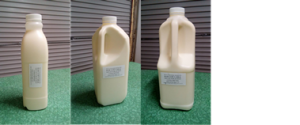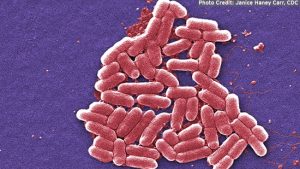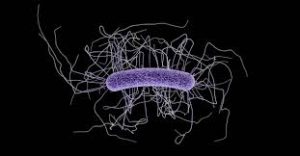Shiga toxin-producing Escherichia coli (STEC) strains are important zoonotic foodborne pathogens, causing diarrhea, hemorrhagic colitis, and life-threatening hemolytic uremic syndrome (HUS) in humans. However, antibiotic treatment of STEC infection is associated with an increased risk of HUS. Therefore, there is an urgent need for early and effective therapeutic strategies.
 Here, we isolated lytic T7-like STEC phage PHB19 and identified a novel O91-specific polysaccharide depolymerase (Dep6) in the C terminus of the PHB19 tailspike protein. Dep6 exhibited strong hydrolase activity across wide ranges of pH (pH 4 to 8) and temperature (20 to 60°C) and degraded polysaccharides on the surface of STEC strain HB10. In addition, both Dep6 and PHB19 degraded biofilms formed by STEC strain HB10.
Here, we isolated lytic T7-like STEC phage PHB19 and identified a novel O91-specific polysaccharide depolymerase (Dep6) in the C terminus of the PHB19 tailspike protein. Dep6 exhibited strong hydrolase activity across wide ranges of pH (pH 4 to 8) and temperature (20 to 60°C) and degraded polysaccharides on the surface of STEC strain HB10. In addition, both Dep6 and PHB19 degraded biofilms formed by STEC strain HB10.
In a mouse STEC infection model, delayed Dep6 treatment (3 h postinfection) resulted in only 33% survival, compared with 83% survival when mice were treated simultaneously with infection. In comparison, pretreatment with Dep6 led to 100% survival compared with that of the control group. Surprisingly, a single PHB19 treatment resulted in 100% survival in all three treatment protocols. Moreover, a significant reduction in the levels of proinflammatory cytokines was observed at 24 h postinfection in Dep6- or PHB19-treated mice. These results demonstrated that Dep6 or PHB19 might be used as a potential therapeutic agent to prevent STEC infection.
IMPORTANCE Shiga toxin-producing Escherichia coli (STEC) is an important foodborne pathogen worldwide. The Shiga-like toxin causes diarrhea, hemorrhagic colitis, and life-threatening hemolytic uremic syndrome (HUS) in humans. Although antibiotic therapy is still used for STEC infections, this approach may increase the risk of HUS. Phages or phage-derived depolymerases have been used to treat bacterial infections in animals and humans, as in the case of the “San Diego patient” treated with a phage cocktail. Here, we showed that phage PHB19 and its O91-specific polysaccharide depolymerase Dep6 degraded STEC biofilms and stripped the lipopolysaccharide (LPS) from STEC strain HB10, which was subsequently killed by serum complement in vitro. In a mouse model, PHB19 and Dep6 protected against STEC infection and caused a significant reduction in the levels of proinflammatory cytokines. This study reports the use of an O91-specific polysaccharide depolymerase for the treatment of STEC infection in mice.
A novel tail-associated O91-specific polysaccharide depolymerase from a podophage reveals lytic efficacy of shiga toxin-producing Escherichia coli, 28 February 2020
Applied and Environmental Microbiology
Yibao Chen, Xiangmin Li, Shuang Wang, Lingyu Guan, Xinxin Li, Dayue Hu, Dongyang Gao, Jiaoyang Song, Huanchun Chen, Ping Qian
DOI: 10.1128/AEM.00145-20











